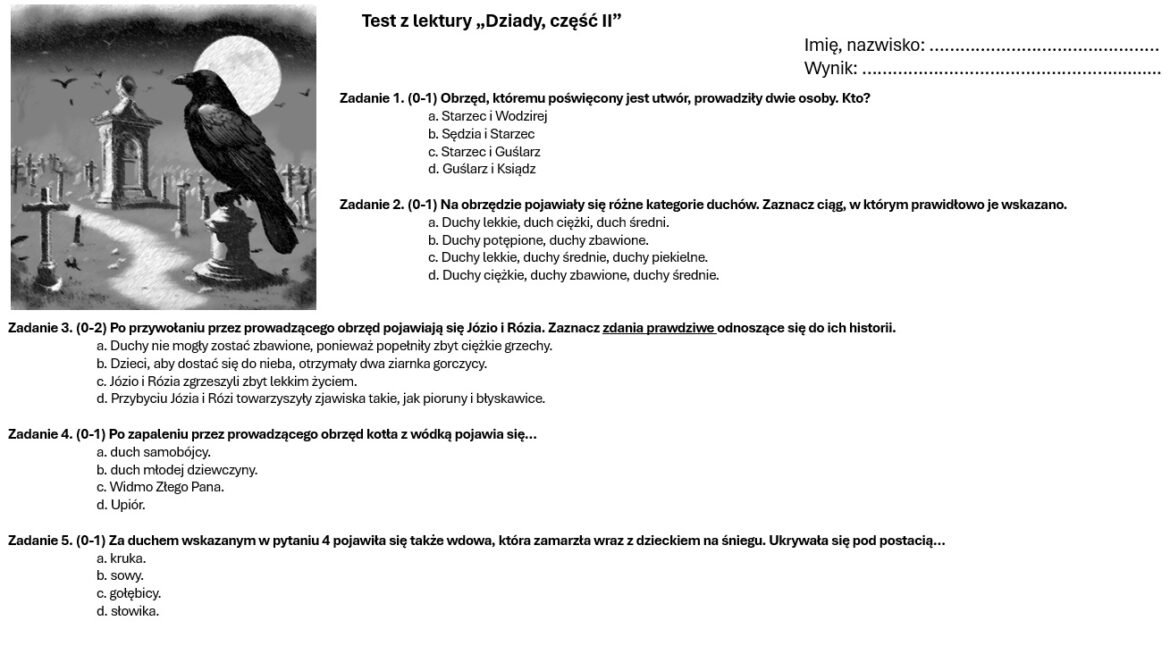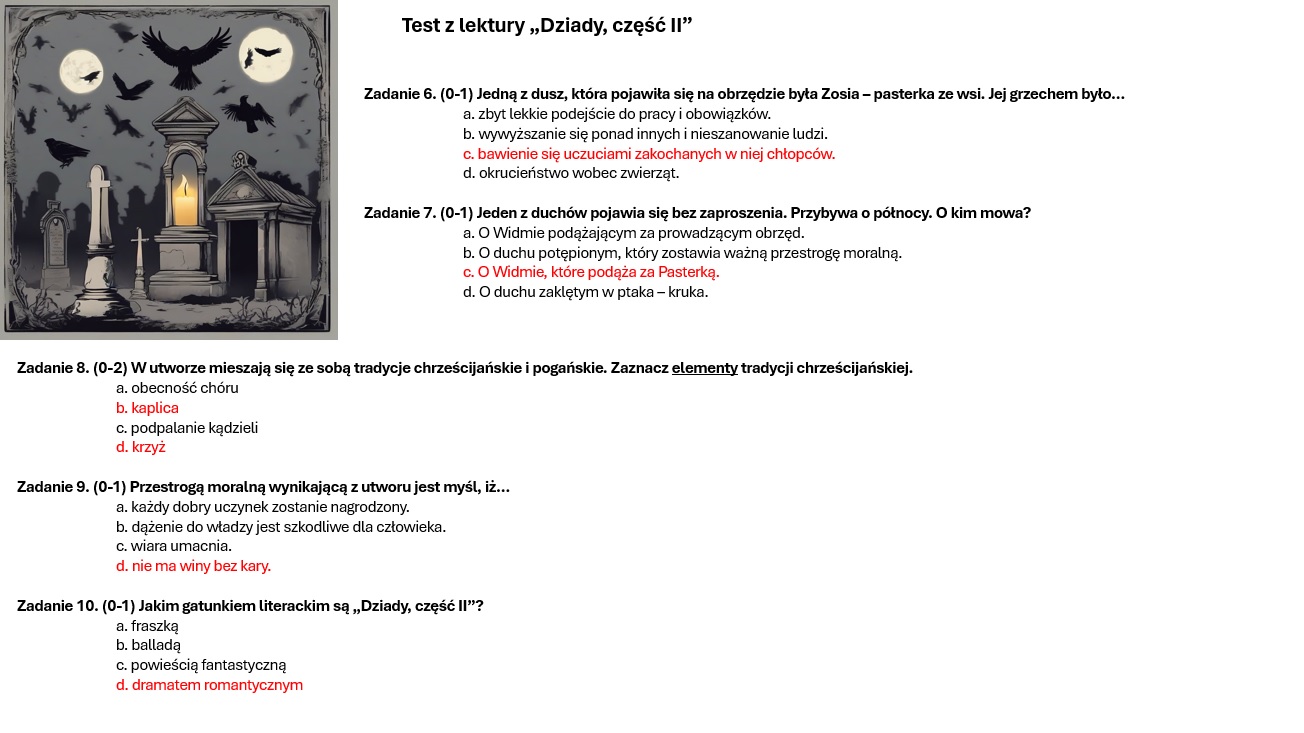Dziady Cz 2 Test Podsumowujący

Czy czujesz dreszcze, myśląc o teście z Dziadów cz. II? Wiem, przez co przechodzisz. To tekst pełen symboliki, ludowych wierzeń i moralnych dylematów. Ale bez obaw, ten artykuł jest Twoim kompasem w gąszczu pytań i zagadek związanych z tym dramatem romantycznym.
Zrozumieć kontekst: Klucz do sukcesu na teście
Zanim przejdziemy do konkretnych pytań testowych, poświęćmy chwilę na zrozumienie szerszego kontekstu Dziadów cz. II. To nie tylko lektura szkolna; to kawałek polskiej kultury, zakorzeniony w tradycjach i wierzeniach ludowych. Zrozumienie tego pozwoli Ci lepiej interpretować tekst i odpowiadać na pytania z większą pewnością.
Co powinieneś wiedzieć o Romantyzmie?
Dziady cz. II są dziełem romantyzmu, epoki, która stawiała na emocje, intuicję i ludowe wierzenia. Zwróć uwagę na:
- Kult natury: Przyroda jest przedstawiona jako siła potężna i tajemnicza, mająca wpływ na ludzkie życie.
- Ludowość: Mickiewicz czerpał inspirację z wierzeń ludowych, wprowadzając do dramatu postacie duchów i obrzęd dziadów.
- Emocjonalność: Dzieło przesiąknięte jest silnymi emocjami – bólem, tęsknotą, żalem.
Pamiętaj, aby na teście odwoływać się do tych elementów, argumentując swoje odpowiedzi.
Przykładowe pytania testowe i strategie odpowiedzi
Testy z Dziadów cz. II często sprawdzają Twoją wiedzę na temat:
- Fabuły: Co się dzieje w dramacie, jakie postacie się pojawiają?
- Tematyki: Jakie przesłanie niesie ze sobą utwór?
- Symboliki: Co oznaczają poszczególne symbole i motywy?
- Kontekstu literackiego: Jak Dziady cz. II wpisują się w romantyzm?
Przyjrzyjmy się kilku przykładowym pytaniom i sposobom na ich skuteczne rozwiązanie:
Pytanie 1: Scharakteryzuj postać Guślarza i określ jego rolę w dramacie.
Strategia:
- Zdefiniuj Guślarza: Kim jest, co robi? Jest to osoba, która prowadzi obrzęd Dziadów, wzywa duchy i pośredniczy między nimi a ludźmi.
- Określ jego rolę: Jaką funkcję pełni w dramacie? Jest on organizatorem obrzędu, ale także obserwatorem i komentatorem wydarzeń.
- Wskaż cechy charakterystyczne: Jakie ma cechy charakteru? Jest poważny, skupiony na obrzędzie, wierzy w moc duchów.
- Odwołaj się do tekstu: Podaj konkretne przykłady z dramatu, które potwierdzają Twoją interpretację.
Przykładowa odpowiedź: Guślarz to osoba przewodnicząca obrzędowi Dziadów. Jego rola w dramacie jest kluczowa – wzywa duchy, modli się i zadaje im pytania. Jest on łącznikiem między światem żywych i umarłych. Guślarz jest poważny i skupiony, wierzy w moc obrzędu. Świadczą o tym jego słowa i gesty podczas wzywania duchów, na przykład: "Ciemno wszędzie, głucho wszędzie, co to będzie, co to będzie?".
Pytanie 2: Jakie moralne przesłanie wynika z pojawienia się duchów w Dziadach cz. II?
Strategia:
- Zidentyfikuj duchy: Jakie duchy się pojawiają i czego im brakuje? Są to duchy lekkie (Józio i Rózia), ciężkie (widmo złego pana) i pośrednie (pasterka Zosia). Każdy z nich cierpi z innego powodu.
- Określ ich potrzeby: Czego potrzebują duchy, aby osiągnąć spokój? Duchy lekkie potrzebują ziarnka gorczycy, duch ciężki potrzebuje wody i odpoczynku, a pasterka Zosia potrzebuje towarzystwa.
- Wyciągnij wnioski: Jakie moralne nauki płyną z ich historii? Dzieło podkreśla znaczenie miłosierdzia, sprawiedliwości i współczucia dla bliźnich.
- Odwołaj się do kontekstu: Jakie wartości romantyzmu są tu widoczne? Podkreślenie roli emocji i ludzkiej solidarności.
Przykładowa odpowiedź: Pojawienie się duchów w Dziadach cz. II ma głębokie przesłanie moralne. Duchy lekkie, Józio i Rózia, uczą, że brak trosk i cierpień nie wystarcza do szczęścia. Duch ciężki, widmo złego pana, pokazuje, że okrucieństwo i brak miłosierdzia prowadzą do wiecznego potępienia. Pasterka Zosia uczy, że samotność i brak miłości uniemożliwiają osiągnięcie pełni szczęścia. Przesłanie utworu podkreśla wagę empatii, sprawiedliwości i troski o innych. Jest to zgodne z ideami romantyzmu, który stawiał na emocje i solidarność ludzką.
Pytanie 3: Zinterpretuj symbolikę ciemności i światła w Dziadach cz. II.
Strategia:
- Zdefiniuj symbole: Co oznaczają ciemność i światło w kontekście dramatu? Ciemność często symbolizuje niewiedzę, strach i nieznane, a światło nadzieję, prawdę i duchowe oświecenie.
- Znajdź przykłady: W jakich sytuacjach pojawiają się te symbole? Ciemność otacza obrzęd Dziadów, podkreślając jego tajemniczy charakter. Światło pojawia się wraz z przybyciem duchów, symbolizując ich obecność.
- Powiąż z tematyką: Jak symbolika ta wiąże się z głównym przesłaniem utworu? Konflikt między ciemnością i światłem odzwierciedla walkę dobra ze złem, nadziei z rozpaczą.
- Odwołaj się do interpretacji krytycznych: Czy inni badacze literatury pisali o tej symbolice? Możesz poszukać krótkich cytatów lub odniesień do analiz literackich.
Przykładowa odpowiedź: Symbolika ciemności i światła w Dziadach cz. II jest niezwykle istotna. Ciemność otacza obrzęd Dziadów, podkreślając jego tajemniczy i groźny charakter. Jest to przestrzeń nieznana, pełna strachu i niewiedzy. Z kolei światło pojawia się wraz z przybyciem duchów, symbolizując ich obecność i próbę komunikacji ze światem żywych. Kontrast między ciemnością i światłem odzwierciedla walkę dobra ze złem, nadziei z rozpaczą, prawdy z fałszem. Symbolika ta wiąże się z głównym przesłaniem utworu, które podkreśla wagę moralnego postępowania i dążenia do światła, czyli prawdy i dobra. Krytycy literaccy często podkreślają rolę ciemności jako symbolu ignorancji i egoizmu, a światła jako symbolu miłosierdzia i oświecenia duchowego. Na przykład, [imię i nazwisko krytyka] w swojej analizie Dziadów zwraca uwagę na... (tu wstaw krótkie odniesienie do analizy).
Praktyczne wskazówki na dzień testu
- Powtórz najważniejsze informacje: Przejrzyj streszczenie utworu, charakterystyki postaci i główne motywy.
- Zorganizuj swoje notatki: Przygotuj sobie notatki z ważnymi cytatami i argumentami, które możesz wykorzystać w odpowiedziach.
- Przeczytaj uważnie pytania: Zanim zaczniesz pisać, upewnij się, że dobrze rozumiesz, o co jesteś pytany.
- Planuj swoje odpowiedzi: Zanim zaczniesz pisać pełną odpowiedź, zrób krótki plan – jakie argumenty chcesz przedstawić i w jakiej kolejności.
- Zarządzaj czasem: Podziel czas przeznaczony na test tak, aby mieć wystarczająco dużo czasu na wszystkie pytania.
- Pisz czytelnie i starannie: Estetyczna i czytelna praca z pewnością wpłynie na pozytywny odbiór Twojej odpowiedzi.
Pamiętaj, że kluczem do sukcesu jest opanowanie wiedzy, zrozumienie kontekstu i spokój. Powodzenia na teście!
Podsumowanie
Mam nadzieję, że ten artykuł pomógł Ci lepiej przygotować się do testu z Dziadów cz. II. Pamiętaj, że zrozumienie utworu, analiza symboliki i powiązanie go z kontekstem historycznym i literackim to klucz do sukcesu. Powodzenia!



